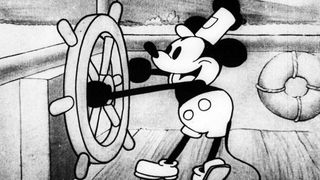Who Created The 12 Principles Of Animation
Understand Disney's 12 principles of animation

Disney's 12 principles of animation were start introduced past animators Ollie Johnston and Frank Thomas in their volume The Illusion of Life: Disney Animation, first released in 1981. Through examining the work of leading Disney animators from the 1930s onwards, this book sees Johnston and Thomas eddy their arroyo down to 12 basic principles of animation.
Forming the ground of all blitheness work, these principles are relevant for a number of different fields. Though the clearest use is for animating a character (encounter our character design tips hither), these rules are likewise an invaluable guide in other areas, for instance, when introducing motion into your interface with some CSS animation.

Want to know more about the latest developments in 3D and digital art? Don't miss Vertex Week 2022 , the ultimate virtual event for the digital art community with guest appearances from Pixar's Dylan Sisson and digital artist and animator Aaron Blaise. There'due south also a talk on creating your own universe beyond comics, TV, games and film with illustrator Justin Gerrard.
Disney's 12 principles of animation
In this article, we take a closer look at each blitheness principle. To see them in activeness, you could consider signing up to Disney Plus or endeavor them out yourself with the best tablets for animation paired with the all-time blitheness software. Once you empathise these 12 principles of animation, yous'll exist able to take your motion work to the next level.
This article features GIFs from Vincenzo Lodigiani, who also made the short video The Illusion of Life (below).
- Acquire more about animation with a 3D World magazine subscription
01. Squash and stretch
The squash and stretch principle is considered the most important of the 12 principles of animation. When practical, information technology gives your animated characters and objects the illusion of gravity, weight, mass and flexibility. Think about how a bouncing rubber brawl may react when tossed into the air: the brawl stretches when it travels upwards and down and squishes when information technology hits the ground.
When using squash and stretch, it'southward important to keep the object's volume consistent. So when yous stretch something information technology needs to become thinner, and when you squash something information technology needs to get wider.
- Mickey Mouse from above is still the most haunting thing online
02. Anticipation
Anticipation helps to prepare the viewer for what'due south most to happen. When applied, it has the effect of making the object'south action more realistic.
Consider how if might expect if you lot were to jump in the air without bending your knees, or mayhap to throw a brawl without start pulling your arm back. It would announced very unnatural (information technology may not fifty-fifty be possible to spring without angle your knees!). In the same way, animating movements without a flicker of anticipation volition also make your motion seem bad-mannered, stale and lifeless.
03. Staging
Staging in animation is a lot like composition in artwork. What nosotros mean by that is, you should use motion to guide the viewer's eye and describe attention to what's of import within the scene. Keep the focus on what'south of import within the scene, and proceed the motion of everything else of not-importance to a minimum.
04. Direct alee action and pose to pose
There are two ways to handle drawing animation: straight alee and pose to pose. Each has its ain benefits, and the two approaches are often combined. Straight alee action involves cartoon frame-past-frame from kickoff to finish. If you're looking for fluid, realistic movements, straight ahead action is your best bet.
With the pose to pose technique, you lot draw the beginning frame, the finish frame, and a few key frames in-between. And then you go back and consummate the residuum. This technique gives you a bit more than control inside the scene and allows you lot to increment the dramatic result of the move.
05. Follow through and overlapping action
When objects come to a standstill subsequently being in move, different parts of the object will end at unlike rates. Similarly, not everything on an object will move at the same charge per unit. This forms the essence of the fifth of Disney'southward principles of blitheness.
If your character is running across the scene, their arms and legs may be moving at a different charge per unit from their head. This is overlapping action. Likewise, when they stop running, their hair will likely continue to move for a few frames earlier coming to rest – this is follow through. These are important principles to empathise if y'all want your blitheness to flow realistically.
06. Slow in and tedious out
The best way to sympathise slow in and slow out is to retrieve most how a machine starts up and stops. It will beginning moving slowly, before gaining momentum and speeding upwards. The reverse volition happen when the automobile brakes. In animation, this effect is achieved by calculation more frames at the commencement and end of an action sequence. Apply this principle to give your objects more life.
07. Arc
When working in animation, it's best to stick with the laws of physics. Near objects follow an arc or a path when they're moving, and your animations should reverberate that arc. For example, when you toss a ball into the air, it follows a natural arc as the effects of the Globe'south gravity human activity upon it.
08. Secondary action
Secondary deportment are used to support or emphasise the principal action going on within a scene. Calculation secondary actions help add more dimension to your characters and objects.
For instance, the subtle motion of your character's hair equally they walk, or possibly a facial expression or a secondary object reacting to the first. Whatever the case may exist, this secondary activeness should not distract from the principal 1.
09. Timing
For this principle of blitheness we need to wait to the laws of physics once again, and utilize what nosotros see in the natural globe to our animations. In this case, the focus is on timing.
If yous move an object more speedily or slowly than it would naturally motion in the real earth, the issue won't exist believable. Using the right timing allows you to control the mood and the reaction of your characters and objects. That's non to say you tin can't push button things a little (peculiarly if you're creating an imaginary globe) – just if you do, exist consequent.
10. Exaggeration
Too much realism can ruin an blitheness, making it appear static and deadening. Instead, add some exaggeration to your characters and objects to make them more than dynamic. Discover ways to push the limits simply beyond what's possible, and your animations will popular.
xi. Solid drawing
You demand to understand the basics of drawing. This includes knowing how to describe in 3-dimensional infinite and understanding form and anatomy, weight and volume, and lights and shadows.
While yous can push the limits hither, likewise, it's important to remain consistent. If your world has wonky doors and a warped perspective, keep that perspective throughout the entire animation. Otherwise, things will fall apart.
12. Entreatment
Your characters, objects, and the earth in which they live demand to appeal to the viewer. This includes having an easy-to-read design, solid drawing, and a personality. There is no formula for getting this correct, just it starts with strong graphic symbol evolution and being able to tell your story through the art of animation.
Related articles:
- The 12 Best YouTube art channels
- Disney Plus movies: The best films on Disney+ right now
- Must-see art shows on Disney Plus

Cheers for reading 5 articles this calendar month* Bring together now for unlimited access
Savour your commencement month for just £one / $1 / €i
*Read 5 costless articles per month without a subscription

Join now for unlimited admission
Try first month for just £i / $1 / €1
Related articles
Source: https://www.creativebloq.com/advice/understand-the-12-principles-of-animation
Posted by: anthonypernihiststo.blogspot.com


0 Response to "Who Created The 12 Principles Of Animation"
Post a Comment